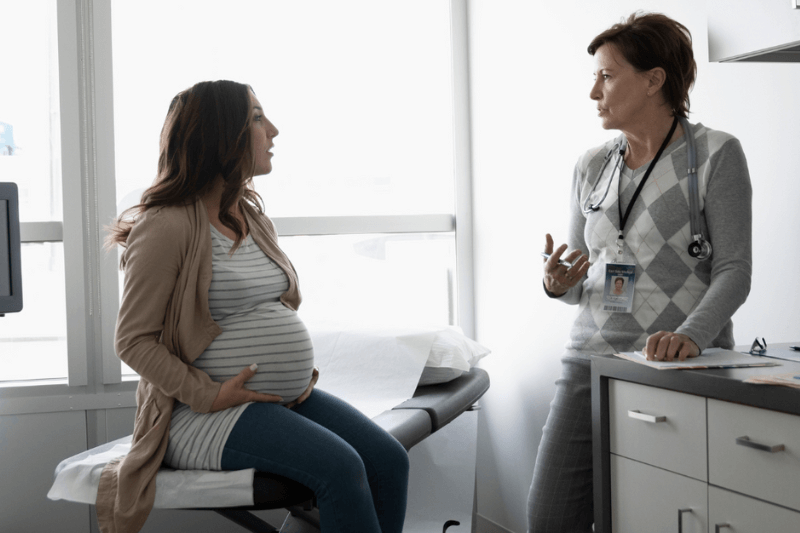Adenomyosis is when the lining of the womb (uterus) grows into the muscle wall of the womb, causing enlargement, bleeding and pain. It can affect one in 10 women and is more commonly diagnosed in women over 301. It can affect anyone who has a period.
While there’s no cure, there’s treatment available that can help with symptoms.
What causes adenomyosis?
The exact cause of adenomyosis isn't fully understood, but several factors are believed to contribute to its development:
- Hormonal factors: Oestrogen, progesterone, prolactin, and other hormones may play a role in the development of adenomyosis. The condition is often seen in women in their reproductive years when hormone levels are higher.
- Tissue injury: Some theories suggest that uterine injury, such as during childbirth or surgery, might lead to adenomyosis by allowing endometrial tissue to invade the uterine muscle.
- Inflammation: Chronic inflammation of the uterine lining may contribute to the condition.
- Genetic factors: There’s no conclusive evidence that adenomyosis is directly hereditary, although some studies suggest a potential genetic component.
- Age: It’s more common in women over 30, although it can occur in younger women as well.
- Motherhood: According to the NHS, you may be more likely to develop adenomyosis if you’ve given birth1. Pregnancy and childbirth can lead to both the stretching and weakening of the uterine lining, making it become a lot more susceptible to developing adenomyosis. Hormonal fluctuations that occur during pregnancy and postpartum are also seen to potentially play a role in the development of the condition2.
Since the causes are not fully understood, it’s important to consult with your doctor for an accurate diagnosis and understanding of your individual risk factors.
Adenomyosis symptoms
Some symptoms can affect your periods, such as:
- Painful periods
- Heavy bleeding during your period
Other symptoms can happen any time during your menstrual cycle, such as:
- Bloating, heaviness or fullness in your tummy (abdomen)
- Pain during sex
- Painful bowel movements
- Ongoing pelvic pain (pain in the lower part of your tummy)
Some people with adenomyosis have no symptoms, which can mean that many women aren’t aware they have it.
What’s the difference between adenomyosis and endometriosis?
Both are gynaecological conditions that involve endometrial tissue growing in the wrong place, cause pelvic pain, heavy bleeding, and cramping. However, in endometriosis, tissue spreads outside of the uterus, such as on the bladder or ovaries. In adenomyosis, it grows in the uterine muscle.
Diagnosis
Receiving a diagnosis of adenomyosis typically involves a combination of evaluating symptoms, physical exams, and imaging tests. Here's how the process generally works:
- Symptom evaluation: The first step is discussing your symptoms with a healthcare provider.
- Physical examination: A pelvic exam may be performed to check for an enlarged or tender uterus.
- Imaging tests:
Ultrasound - This can help identify changes in the uterus that might suggest adenomyosis.
Magnetic resonance imaging (MRI) - An MRI provides more detailed images and can be particularly useful in identifying adenomyosis. - Additional tests: In some cases, a biopsy or hysteroscopy may be recommended to rule out other conditions.
It's important to consult with a healthcare provider who can guide you through these steps based on your symptoms and medical history to reach an accurate diagnosis.
It’s also important to note that your symptoms can be caused by many other conditions, including pelvic floor muscle spasm, pelvic infections, irritable bowel syndrome, fibroids and cysts – so in some cases, these steps can rule out adenomyosis and/or endometriosis and provide a different diagnosis and next steps.
Treatment for adenomyosis
It depends on the severity of your symptoms, your age and desire to maintain fertility. Common treatment options include:
- Medication:
Nonsteroidal anti-inflammatory drugs (NSAIDs) - These can help relieve pain and reduce menstrual flow.
Hormonal treatments - Contraceptive pills, hormone-releasing IUDs (intrauterine device), or other hormonal therapies can help regulate or reduce menstrual bleeding and alleviate pain.
Gonadotropin-releasing hormone (GnRH) agonists - These can temporarily shrink adenomyosis and reduce symptoms by lowering oestrogen levels. - Uterine artery embolisation (UAE): This minimally invasive procedure reduces blood flow to the adenomyosis, causing it to shrink and alleviate symptoms.
- Endometrial ablation: This is a surgical procedure that involves thinning and destroying the lining of your womb without removing it, to reduce heavy bleeding. However, it's generally not recommended for women who wish to become pregnant in the future.
- Hysterectomy: The surgical removal of the uterus is considered the definitive treatment for adenomyosis, particularly for women with severe symptoms who do not wish to preserve fertility.
- Lifestyle changes and home remedies: Regular exercise, heat therapy, and dietary changes might help manage symptoms, though these are supportive measures rather than treatments.
It's important to discuss these options with your healthcare provider to determine the best course of action based on your specific situation.
Common questions
Can you have both adenomyosis and endometriosis at the same time?
Yes. While they’re distinct conditions, they can coexist in your body at the same time.
Can I get pregnant with adenomyosis?
It’s possible to become pregnant, however, because adenomyosis can impact the uterine environment, it can sometimes affect fertility.
Some studies have found that it can heighten the risk of pregnancy complications, for example a 2023 paper3 studying 7608 pregnant women with adenomyosis found the risks included premature birth (a 42% higher risk than in the normal population) and restricted intrauterine growth (reflecting a risk 25% higher than in the normal population).
Yet, other studies4 suggest that due to the hormonal changes involved in pregnancy and childbirth (notably high levels of progesterone2), adenomyosis symptoms can sometimes be supressed. During pregnancy, the uterine lining may also undergo changes that can improve symptoms. However, the exact mechanisms behind this aren’t yet fully understood2.
If you have adenomyosis and are looking to start a family, speak to your doctor as they can provide personalised advice specific to you.
Is adenomyosis hereditary?
There’s no conclusive evidence that adenomyosis is directly hereditary, although some studies suggest a potential genetic component. Having a family history of adenomyosis or related conditions might increase the likelihood of developing it, but more research is needed to establish a clear genetic link.
Can adenomyosis cause cancer?
Cancer arising from adenomyosis is very rare, with transformation occurring in only 1% of cases and in older individuals5.
However, it can coexist with other conditions that might have cancerous potential, such as atypical endometrial hyperplasia.
It's important to monitor any unusual symptoms and maintain regular check-ups with your healthcare provider to ensure overall uterine health.
If you have concerns about adenomyosis and cancer risk, discussing them with a healthcare professional can provide clarity and guidance tailored to your specific health needs.
Does adenomyosis cause weight gain?
Adenomyosis itself doesn’t directly cause weight gain, but the symptoms associated with adenomyosis, such as heavy menstrual bleeding and chronic pelvic pain, can lead to lifestyle changes or stress that might contribute to indirect weight changes.
Some treatments for adenomyosis, particularly hormonal therapies, can potentially lead to weight gain as a side effect.
If you're experiencing unexplained weight gain and suspect it may be related to adenomyosis or its treatment, it's a good idea to discuss this with your healthcare provider for personalised advice and management.
We hope this article has provided the information you were looking for on adenomyosis and given you the confidence to seek professional medical support should you or a loved one be experiencing symptoms. Be honest and tell your doctor the true extent of your issues during your appointment/s to ensure you receive the best next steps for you.
Useful resources
The Adeno Gang: A UK charity that supports, advocates and informs those with adenomyosis and other menstrual health conditions to learn, educate and share knowledge on menstrual health and womb wellness.
Endometriosis UK: Provides information and support, as well as helpful webinar recordings on adenomyosis.
Pelvic Pain Support Network: Support, information and advocacy for those with pelvic pain, their families and carers.
Further reading from our women’s health hub: Endometriosis symptoms, diagnosis and treatment.
References
- Adenomyosis – NHS
- Adenomyosis and pregnancy: Everything you need to know – Women’s Health
- Adenomyosis in Pregnancy – Should It Be Managed in High-Risk Obstetric Units? – National Library of Medicine
- Pregnancy is associated with reduced progression of symptomatic adenomyosis: a retrospective pilot study – PubMed
- Adenomyosis and Its Possible Malignancy: A Review of the Literature – MDPI














